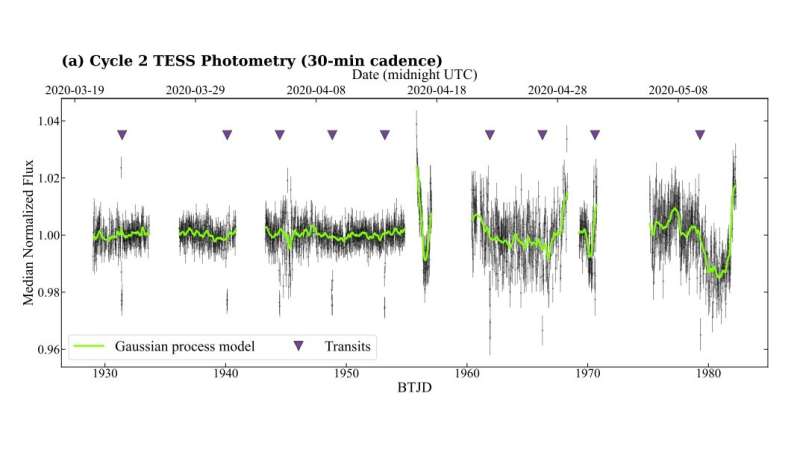The median normalized TESS long-cadence light curve for TOI-3984A. Credit: Cañas et al, 2023
Astronomers report the detection of two new gas giant exoplanets using NASA's Transiting Exoplanet Survey Satellite (TESS). The newfound alien worlds, designated TOI-3984A b and TOI-5293A b, have very short orbital periods. The discovery was detailed in a paper published February 15 on the pre-print server arXiv.
TESS is conducting a survey of about 200,000 of the brightest stars near the sun with the aim of searching for transiting exoplanets. So far, it has identified nearly 6,200 candidate exoplanets (TESS Objects of Interest, or TOI), of which 3,032 have been confirmed so far.
A group of astronomers led by Caleb I. Cannas of the Pennsylvania State University (PSU) has recently confirmed another two TOI planets monitored by TESS. They report that transit signals have been identified in the light curves of two M-dwarf stars known as TOI-3984A and TOI-5293A—primary stars of two different binary systems. The planetary nature of these signals was confirmed by follow-up observations using ground-bases facilities.
"We confirm the planetary nature of two gas giants discovered by TESS to transit M dwarfs with stellar companions at wide separations," the researchers wrote.
TOI-3984A b has a radius of about 0.71 Jupiter radii and a mass of 0.14 Jupiter masses, which yields a density at a level of 0.49 g/cm3. The planet orbits its parent star every 4.35 days, at a distance of about 0.041 AU from it, and its equilibrium temperature was estimated to be 563 K. Based on its parameters, the astronomers classified TOI-3984A b as a sub-Saturn.
The host TOI-3984A is an M4 dwarf about half the size and mass of the sun, located approximately 353 light years away from the Earth. The star is estimated to be between 0.7 and 5.1 billion years old and has an effective temperature of 3,476 K. TOI-3984A has a white dwarf companion at a projected separation of 356 AU.
The exoplanet TOI-5293A b is about the size of Jupiter, however less massive, with a mass of about 0.54 Jupiter masses. Therefore, the planet's density is approximately 0.56 g/cm3. TOI-5293A b has an orbital period of about 2.93 days and is separated from its host star by approximately 0.034 AU. The equilibrium temperature of this gas giant is estimated to be 675 K, thus the researchers classified it as a hot Jupiter.
At a distance of some 524 light years, TOI-5293A is an M3 dwarf, also about half the size of our sun. The star has an effective temperature of 3,586 K and its age is estimated to be between 0.7 and 5.1 billion years. It has an M-dwarf companion at a projected separation of 579 AU.
Summing up the results, the authors of the paper underlined that TOI-3984A b and TOI-5293A b are two of the coolest gas giants among the population of known hot Jupiter-sized gas exoplanets orbiting M-dwarf stars. They added that both planets are great targets for further atmospheric characterization studies.
More information: Caleb I. Cañas et al, TOI-3984 A b and TOI-5293 A b: two temperate gas giants transiting mid-M dwarfs in wide binary systems, arXiv (2023). DOI: 10.48550/arxiv.2302.07714
Journal information: arXiv
© 2023 Science X Network
























